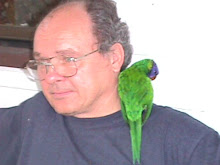 View of four parrots. The one on the left is clearly a male; the one at the right, a female. On the feeder itself, the right-hand bird is another male Australian King-Parrot but what is the one on the left?
View of four parrots. The one on the left is clearly a male; the one at the right, a female. On the feeder itself, the right-hand bird is another male Australian King-Parrot but what is the one on the left?p.s. The photo also shows the view from our south verandah
One could wax lyrical about the bird but in simple terms it is probably an Australian King-Parrot Alisterus scapularis that isn’t quite an Australian King-Parrot.
Yesterday, following a day at work, Fay and I found ourselves relaxing on the east verandah, enjoying a glass of the 2007 Thompson Estate Andrea Reserve cabernet merlot [from the, Margaret River, Western Australia], listening to a little Dvorak [Symphony No.9 in E Minor, Op. 95]. We were not particularly birding although from the settee on this verandah we could look across to the orchard and what we refer to as the “Middle Compound.” When not out in the field, our binoculars are usually to be found on the settee, along with my camera [a simple Sony 100 with a 70-300mm telephoto lens almost permanently attached].
The Crested Pigeons Ocyphaps lophotes and Bar-shouldered Doves Geopelia humeralis were quietly feeding from the grain I had scattered in the Middle Compound for the four young cockerels we’re rearing. A female Magpie-lark Grallina cyanoleuca was perched in a tree at the further end of the orchard while a pair of Galahs Eolophus roseicappilus were busily trying to shove more food down their juvenile’s throat to shut it up; young begging galahs can make enough noise to awaken the dead.
There was a pair of Australian King-Parrots at the south verandah feeder. The now almost traditional noisy but harmless kerfuffle between the parrots and the more aggressive Rainbow Lorikeets Trichoglossus haematodus had passed; the latter had ousted the gentler King-Parrots but had then abandoned the sunflower seeds to re-indulge in more favoured fodder on the south feeder.
I happened to look up as from the corner of my eye [albeit diabetes having now reduced the functioning of that eye to 60%] I noted another King-Parrot alight on the terracotta feeder. With its back turned to me I casually called it a female.
Only it wasn’t. Or rather, it didn’t quite fit the complete bill for an Australian King-Parrot.
 Note the shade of green and the extent of the red underbelly. All wrong for an Australian King-Parrot.
Note the shade of green and the extent of the red underbelly. All wrong for an Australian King-Parrot.The green was wrong, too light, more in line with the Red-winged Parrot Aporosmictus erythropterus that are occasional visitors to the property. Fay, an artist with a far better eye that I have, thinks even that it not quite on the mark; the green of this bird was a little paler than even Red-winged Parrot green.
When the new arrival came alongside the male at the south verandah terracotta feeder their differences in size became immediately obvious. The male Australian King-Parrot clearly exceeded 40cm in length, as per the field guides and, perhaps more importantly, in line with the description proffered by Higgins [Handbook of Australian, New Zealand & Antarctic Birds, Vol. 4, 1999]. The interloper, if such it be, was barely 30cm from bill tip to the end of its tail.
 Again, note the paleness of the green and the extent of the red under the belly. The flush of red at the upper breast suggests this is approaching a male but at what developmental stage?
Again, note the paleness of the green and the extent of the red under the belly. The flush of red at the upper breast suggests this is approaching a male but at what developmental stage?Over the years, both prior to moving here to Nanango and certainly since taking up residence in Allen Road, Fay and I have observed an incalculable number of Australian King-Parrot specimens; adult males and adult females together with countless juveniles in varying degrees of development. Yet none has ever matched this bird in size or colouration.
We considered the possibility of it being a slightly older bird, perhaps a first immature male or female. Higgins [1999] separates the males at this stage from their younger counterparts by the “small scattered orange-red patches on breast, throat and sometimes head.” First immature females are more difficult, their plumage being much as adult females but retaining juvenile remiges and rectrices.
However, at this stage in their development, the red on the male’s breast would be more clearly demarcated, approaching its adult stage; its bill would be acquiring orange or red on the upper mandible with a dark grey tip. The equivalent female would have a brown upper mandible.
While it would appear that Fay and I were almost indisputably looking at an Australian King-Parrot, anomalies remain unanswered. The intruder did not behave like a youngster and was certainly self-feeding. The differences in size remain indisputable.
In the end it flew off with one of the two adult males on the verandah.
So, the question is, what do we have here? Is it no more than an aberrant Australian King-Parrot or perhaps an anomalous Red-winged Parrot. Or is it simply a hybrid between the two?
 The entire jizz appears to be wrong for Australian King-Parrot but what else can it be? A hybrid? Possibly a cross between Australian King-Parrot and Red-winged Parrot?
The entire jizz appears to be wrong for Australian King-Parrot but what else can it be? A hybrid? Possibly a cross between Australian King-Parrot and Red-winged Parrot?
No comments:
Post a Comment